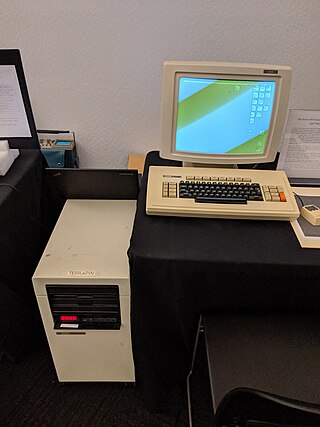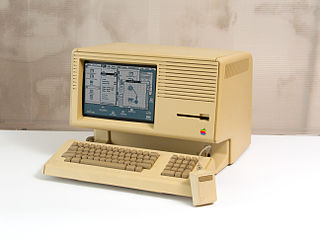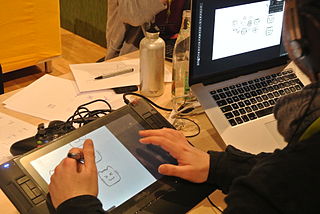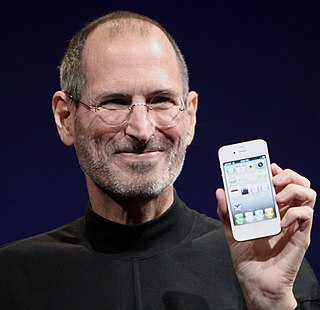
William "Bill" D. Atkinson is an American computer engineer, computer programmer and photographer. Atkinson worked at Apple Computer from 1978 to 1990. Some of Atkinson's noteworthy contributions to the field of computing include Macintosh QuickDraw and Lisa LisaGraf (Atkinson independently discovered the midpoint circle algorithm for fast drawing of circles by using the sum of consecutive odd numbers), Marching ants, the double-click, Menu bar, the selection lasso, MacPaint (FatBits), HyperCard, Atkinson dithering, and the app PhotoCard.

Stephen Gary Wozniak, also known by his nickname Woz, is an American technology entrepreneur, electrical engineer, computer programmer, philanthropist, and inventor. In 1976, he co-founded Apple Computer with his early business partner Steve Jobs. Through his work at Apple in the 1970s and 1980s, he is widely recognized as one of the most prominent pioneers of the personal computer revolution.

Lisa is a desktop computer developed by Apple, produced from January 19, 1983 to August 1, 1986, and succeeded by Macintosh. It is generally considered the first mass-market personal computer operable through a graphical user interface (GUI). In 1983, a machine like the Lisa was still so expensive that it was primarily marketed to individual and small and medium-sized businesses as a groundbreaking new alternative to much bigger and more expensive mainframes or minicomputers such as from IBM, that either require additional, expensive consultancy from the supplier, hiring specially trained personnel, or at least, a much steeper learning curve to maintain and operate. Earlier GUI-controlled personal computers were not mass-marketed; for example, Xerox PARC manufactured its Alto workstation only for Xerox and select partners from the early to mid-1970s.

The Xerox Star workstation, officially named Xerox Star 8010 Information System, is the first commercial personal computer to incorporate technologies that have since become standard in personal computers, including a bitmapped display, a window-based graphical user interface, icons, folders, mouse (two-button), Ethernet networking, file servers, print servers, and email.

Jef Raskin was an American human–computer interface expert who conceived and began leading the Macintosh project at Apple in the late 1970s.

John Sculley III is an American businessman, entrepreneur and investor in high-tech startups. Sculley was vice-president (1970–1977) and president of PepsiCo (1977–1983), until he became chief executive officer (CEO) of Apple Inc. on April 8, 1983, a position he held until leaving on October 15, 1993. In 1987, Sculley was named Silicon Valley's top-paid executive, with an annual salary of US$10.2 million.
Peter Norton is an American programmer, software publisher, author, and philanthropist. He is best known for the computer programs and books that bear his name and portrait. Norton sold his software business to Symantec Corporation in 1990.

The Macintosh, later rebranded as the Macintosh 128K, is the original Macintosh personal computer from Apple. It is the first successful mass-market all-in-one desktop personal computer with a graphical user interface, built-in screen and mouse. It was pivotal in establishing desktop publishing as a general office function. The motherboard, a 9 in (23 cm) CRT monochrome monitor, and a floppy drive are in a beige case with integrated carrying handle; it has a keyboard and single-button mouse.

Macintosh Programmer's Workshop (MPW) is a software development environment for the Classic Mac OS operating system, written by Apple Computer. For Macintosh developers, it was one of the primary tools for building applications for System 7.x and Mac OS 8.x and 9.x. Initially MPW was available for purchase as part of Apple's professional developers program, but Apple made it a free download after it was superseded by CodeWarrior. On Mac OS X it was replaced by the Project Builder IDE, which eventually became Xcode.

Macintosh XL is a modified version of the Apple Lisa personal computer made by Apple Computer. In the Macintosh XL configuration, the computer shipped with MacWorks XL, a Lisa program that allowed 64 K Macintosh ROM emulation. An identical machine was previously sold as Lisa 2/10 with the Lisa OS only.

Lawrence Gordon Tesler was an American computer scientist who worked in the field of human–computer interaction. Tesler worked at Xerox PARC, Apple, Amazon, and Yahoo!.

Digital painting is the creation of imagery on a computer, using pixels which are assigned a color. The process uses raster graphics rather than vector graphics, and can render graduated or blended colors in imagery which mimics traditional drawing and painting media.
Armas Clifford "Mike" Markkula Jr. is an American electrical engineer, businessman and investor. He was the original angel investor, first chairman, and second CEO for Apple Computer, Inc., providing critical early funding and managerial support. At the company's incorporation, Markkula owned 26% of Apple, equivalent to each of the shares owned by cofounders Steve Jobs and Steve Wozniak.
Steve Capps is a pioneering American computer programmer and software engineer, who was one of the original designers of the Apple Macintosh computer and co-designers of the Finder in the 1980s. He also led development of the Apple Newton PDA and designed music software such as SoundEdit, before developing user interface (UI) designs for Microsoft's Internet Explorer and online/mobile payment systems.

Bruce Lawrence Horn is a programmer. He created the original Macintosh Finder and the Macintosh Resource Manager for Apple Computer. His signature is amongst those molded to the case of the Macintosh 128K. He has been a distinguished engineer at Siri and Language Technologies at Apple since June 2022.
In user interface design, an interface metaphor is a set of user interface visuals, actions and procedures that exploit specific knowledge that users already have of other domains. The purpose of the interface metaphor is to give the user instantaneous knowledge about how to interact with the user interface. They are designed to be similar to physical entities but also have their own properties. They can be based on an activity, an object (skeuomorph), or a combination of both and work with users' familiar knowledge to help them understand 'the unfamiliar', and placed in the terms so the user may better understand.

Steven Paul Jobs was an American businessman, inventor, and investor best known for co-founding the technology company Apple Inc. Jobs was also the founder of NeXT and chairman and majority shareholder of Pixar. He was a pioneer of the personal computer revolution of the 1970s and 1980s, along with his early business partner and fellow Apple co-founder Steve Wozniak.

The Newton is a specified standard and series of personal digital assistants (PDAs) developed and marketed by Apple Computer, Inc. from 1993 to 1998. An early device in the PDA category — the term itself originating with the Newton — it was the first to feature handwriting recognition. Newton devices run on a proprietary operating system, Newton OS; unlike the company's Macintosh computers, Apple licensed the software to third-parties, who released Newton devices alongside Apple's own MessagePad line.

Through the Looking Glass, also known as Alice, is a 1984 video game written for the Apple Lisa and Apple Macintosh computers. Written by a member of the Lisa and Mac teams, Steve Capps, it was one of the earliest video games on the Mac platform, part of the only games disk officially sold by Apple Computer during that era.

Mac OS is the series of operating systems developed for the Macintosh family of personal computers by Apple Computer, Inc. from 1984 to 2001, starting with System 1 and ending with Mac OS 9. The Macintosh operating system is credited with having popularized the graphical user interface concept. It was included with every Macintosh that was sold during the era in which it was developed, and many updates to the system software were done in conjunction with the introduction of new Macintosh systems.
















